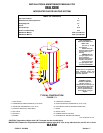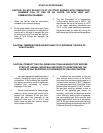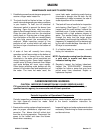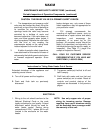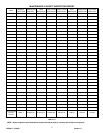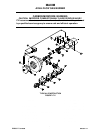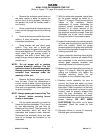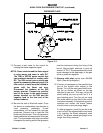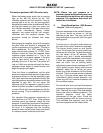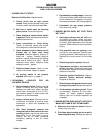PV500-17 05-2000 Section 17
9
MAXIM
AXIAL FLOW GAS BURNER START-UP (continued)
This section pertains to MC120 control only.
When the blower motor starts, the air proving
light on the MC-120 should be on. This
indicates a positive air flow condition. If the air
proving light is not on, turn air proving switch
adjustment screw counter-clockwise until the air
proving light comes on, then turn screw one
turn counter-clockwise. If the gas valves open
and close intermittently during normal
operation, turn screw one half turn counter-
clockwise until this condition ceases. This
procedure should be followed with every
burner.
After purging is complete, terminal 3 energizes
the pilot valve and terminal 4 energizes the
ignition transformer on the control. The pilot is
then established. The VDC reading on the
meter should read a steady 14-17 VDC. Each
different control will have the required flame
response signal stamped on it. This is the
minimum for it to properly operate. If the pilot
fails to light during the initial period, it is
probably due to air in the line. The control will
lock out. Wait one minute and push the flame
safeguard reset button to restart burner and
begin the purge cycle again.
Once the flame is established, set the pilot
pressure (measured downstream of gas valve)
at pressure shown on the tag attached to gas
train. Next, open the main gas valve slowly. Set
manifold pressure at pressure shown on the tag
attached to gas train. Do not screw the
adjusting nut of the regulator in past the point
where no further increase in manifold pressure
is noted. Check the incoming pressure with the
burner running. This is recorded as inlet flow
pressure.
Our standard flow pressure requirement on
these burners is 8" W.C. flow. If the required
manifold cannot be reached, check the inlet
pressure. It should be a minimum of that shown
on the heater decal with the burner running on
full input. It is important that the incoming
pressure does not fall below these minimums
or nuisance control lockouts could occur.
NOTE: Where low gas pressure is a
problem, special arrangements may have
been made to fire the burner with reduced
pressure. The appliance data decal will
reflect this information.
16. Direct Spark Ignition - (DSI) Burners
- No pilot. (See wiring diagram.)
Connect manometer to the manifold test port.
Set the air shutter as shown on the tag
attached to gas train. This may not be the
exact setting you end up with, but it is a good
starting point.
Turn the unit on, using the rocker switch on
the side of the control enclosure assembly.
The burner should come on and ignition
occur. If the burner fails to ignite, there may
have been air in the line. To reset the control,
turn the switch off for 60 seconds (S89
controls only) and it should automatically
reset, or push the reset button on the control.
If after the appropriate prepurge, ignition
does not occur, turn air proving switch
adjustment screw counter-clockwise until TFI
(try for ignition) occurs. Now in order to more
precisely adjust the air failure set point,
slowly turn screw clockwise until the burner
shuts off. Then turn screw counter-clockwise
one turn. If the gas valves open and close
intermittently during normal operation, turn
screw one half turn counter-clockwise until
this condition ceases.
Once the burner fires, set manifold pressure
at pressure shown on the tag attached to gas
train. There will be a tap on the downstream
side of the valve to measure pressure. The
manifold pressure must be taken
downstream of the gas valve. Check the
incoming pressure with the burner running.
This recorded flow pressure must be the
minimum specified on the heater decal.



